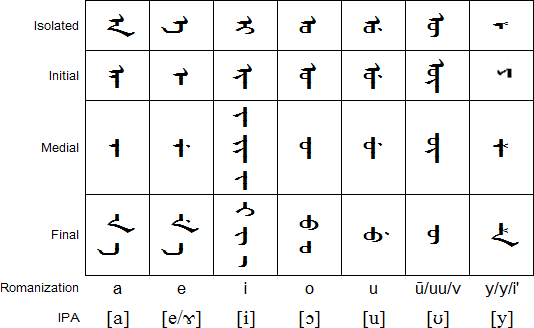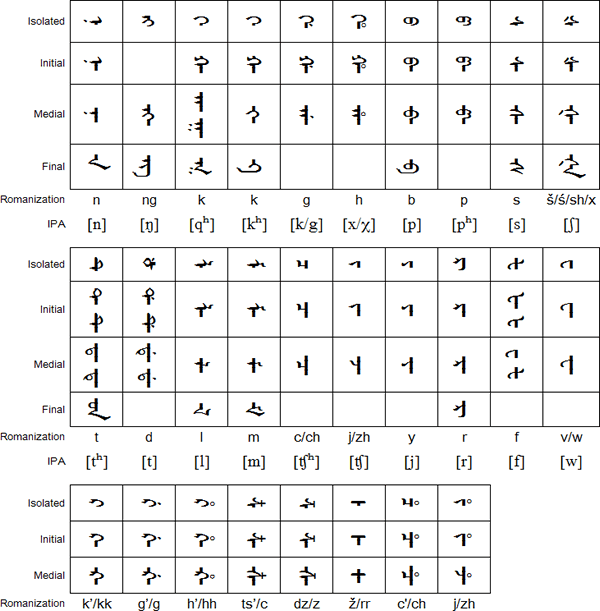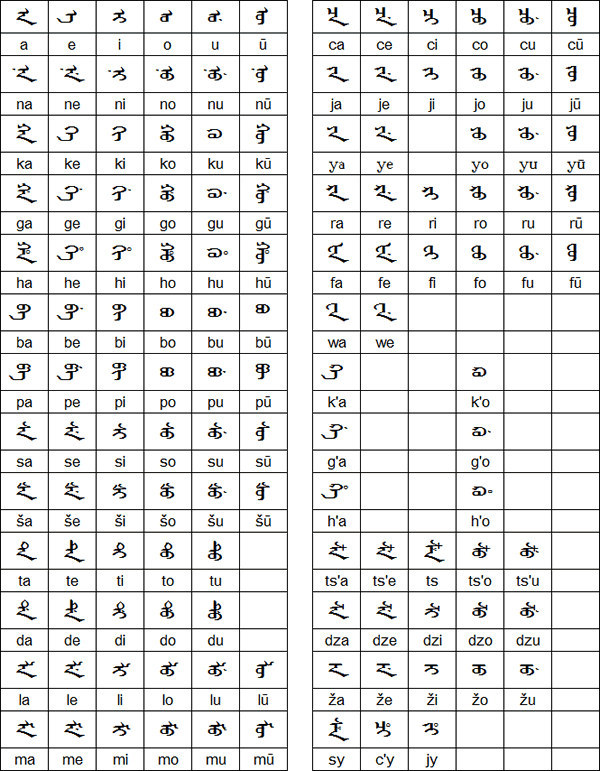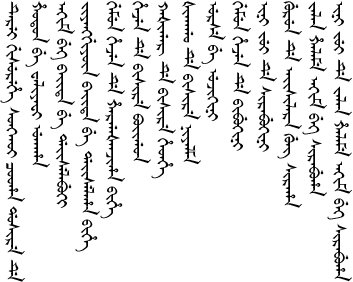In 1644 the Manchus conquered China and established the Ch'ing (Qing) dynasty, which lasted until 1911. For the first 200 years or so of the Ch'ing dynasty, Manchu was the main language of government in China and served as a lingua franca. By the mid 19th century many of the Manchus had adopted Chinese as their first language, however they continued to produce Manchu version of Chinese documents until the end of the dynasty and for sometime afterwards.
Notable features
- Type of writing system: alphabet
- Direction of writing: left to right in vertical columns running from top to bottom.
- Most letters have several different forms: initial, medial and final, which are used at the beginning, middle and end of a word respectively. The vowels also have isolated forms.
- Some letters have different shapes depending on which vowel comes before and/or after them.
Used to write
Manchu, a member of the Tungusic group of Altaic languages. There are currently about 10 million Manchus living mainly in north-eastern China, of whom about 100 speak Manchu and only 20 can read and write it. Most speak only Mandarin.A version of the Manchu script is used to write Xibe, a Tungusic language closely related to Manchu and spoken in Xinjiang in the north west of China by 30,000 people.
Manchu alphabet
Vowels

Note
- The second final form of e is used after k, g and h.
Consonants

Notes
- The first medial form of n is used before vowels; the second is used before consonants
- The first medial form of ng is used before i, o, u and ū; the second is used before e and i
- The first medial form of k is used before a, o and ū; the second is used before consonants
- The first initial and medial forms of t are used before a, o and i; the second initial and medial forms are used before e, u ū; the third medial form is used before consonants
- First initial and medial forms of d are used before a, o and i; the second initial and medial forms are used before e, u and ū
- The first initial and medial forms of f are used before a and e; the second initial and medial forms are used before i, o, u and ū
Numerals

Syllables

Sample text

Translation
Following his advice, when the army was about to enter the town, he abandoned the town and fled. Akim Bek volunteered to handle the affairs, so he did the duty on behalf of the General. He had been to the capital city to present himself before the Emperor. His estate in the city and property in Kashgar, were used to provide the people living in Shikago, left in the capital city, or inherited by his son. He inherited the title of the Duke of Assisting the Nation, and was bestowed the hereditary title of Akim Bek. His son inherited the hereditary title of Akim Bek.Source: http://www.chinahistoryforum.com
Links
Information about Manchuhttp://en.wikipedia.org/wiki/Manchu_language
http://www.ethnologue.com/%5C/15/show_language.asp?code=mnc
http://zh.wikipedia.org/wiki/满文
http://baike.baidu.com/view/56403.htm
Some Manchu words and phrases and part of a story (with audio)
http://online.wsj.com/public/resources/documents/MANCHU-LANGUAGE.html
Manchu fonts
http://sourceforge.net/projects/manchufont/
http://fedoraproject.org/wiki/Mang_Manchu_fonts
http://www.daicing.com/manchu/index.php?page=fonts-downloads
http://www.xenotypetech.com/osxManchu.html
满文输入工具 (Manchu Script Creator)
http://www.soft8.net/c25/1734.htm
Manchu in Unicode
http://www.babelstone.co.uk/Test/Manchu.html









.jpg)
.jpg)


.jpg)





0 comments:
Post a Comment
Note: Only a member of this blog may post a comment.